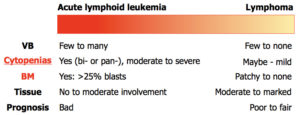Acute lymphoblastic (lymphoid) leukemia and intermediate to large cell lymphoma represent two ends of a spectrum of immature or precursor lymphoid neoplasms. At one end, you have primary bone marrow involvement (defined in human medicine as >25% bone marrow blasts) or ALL. On the other end, the primary site of involvement is a peripheral lymphoid organ (lymph nodes, liver, spleen). Then you have a range between where there is overlap between the two extremes, because ALL can and does infiltrate extramedullary tissue and lymphoma can infiltrate bone marrow and tumor cells can circulate. The main distinction between these diagnoses is the site of involvement (bone marrow or organs?).
Note that this spectrum assumes that a diagnosis of lymphoid neoplasia has been made, because blasts could also be of myeloid origin (which just like lymphoid blasts in ALL can and do infiltrate extramedullary organs in AML).
In dogs, ALL is far less common than lymphoma and is also less common than AML. Cats suffer from lymphoma (renal, gastrointestinal, thymic, hepatic etc) more than ALL and AML is also uncommon (but more common than ALL). In horses, ALL and AML both occur but are less common than lymphoma.

